线性表(Linear List)就是数据排成像一条线一样的结构,数据只有前后两个方向:
数组
概念
数组(Array)是有限个相同类型的变量所组成的有序集合,数组中的每一个变量被称为元素。数组是最为简单、最为常用的数据结构。

数组下标从零开始,为什么呢?
存储原理
数组用一组连续的内存空间来存储一组具有相同类型的数据:

模拟内存存储:
- 灰色格子:被使用的内存
- 橙色格子:空闲的内存
- 红色格子:数组占用的内存
数组可以根据下标随机访问数据。比如一个整型数据 int[] 长度为5:
假设首地址是:1000,int是4字节(32位),实际内存存储是位,随机元素寻址:
a[i]_address=a[0]_address+i*4该公式解释了三个方面:
- 连续性分配
- 相同的类型
- 下标从0开始
操作
- 读取元素
根据下标读取元素的方式叫作随机读取:
int n=nums[2]- 更新元素
nums[3]= 10;注意不要数组越界
读取和更新都可以随机访问,时间复杂度为O(1)
- 插入元素
有三种情况:
尾部插入
在数据的实际元素数量小于数组长度的情况下:
直接把插入的元素放在数组尾部的空闲位置即可,等同于更新元素的操作:

a[6]=10中间插入
在数据的实际元素数量小于数组长度的情况下:
由于数组的每一个元素都有其固定下标,所以首先把插入位置及后面的元素向后移动,腾出地方,再把要插入的元素放到对应的数组位置上:
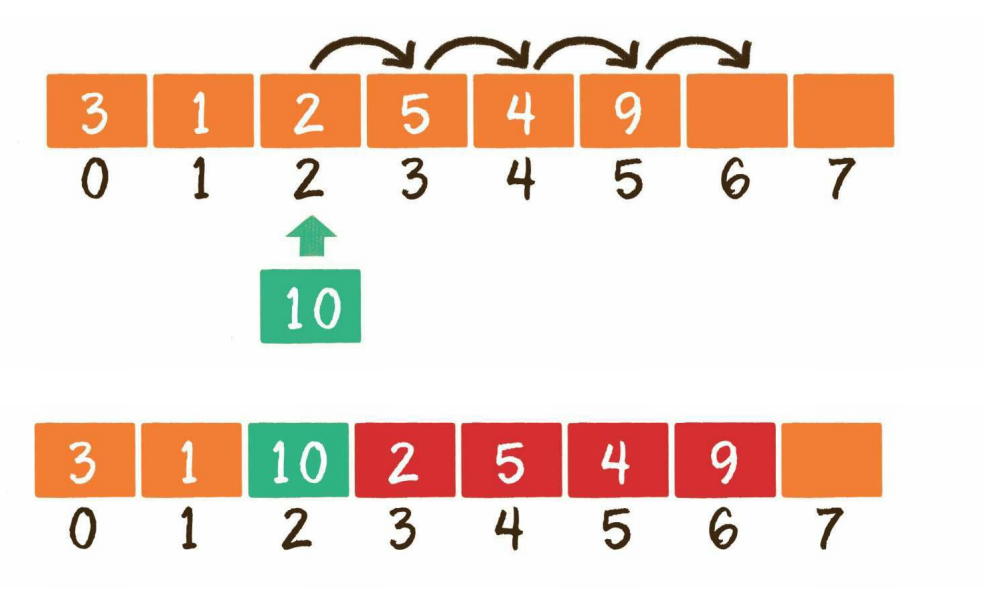
超范围插入
假如现在有一个数组,已经装满了元素,这时还想插入一个新元素,或者插入位置是越界的,这时就要对原数组进行扩容:可以创建一个新数组,长度是旧数组的2倍,再把旧数组中的元素统统复制过去,这样就实现了数组的扩容:

int[] numsNew=new int[nums.length*2];
System.arraycopy(nums,0,numsNew,0,nums.length);
// 原数组就丢掉了,资源浪费
nums=numsNew;- 删除元素
数组的删除操作和插入操作的过程相反,如果删除的元素位于数组中间,其后的元素都需要向前挪动1位:
for(int i=p;i<nums.length;i++){
nums[i-1]=nums[i];
}完整的代码:
package com.rubin.datastructure.array;
import java.util.Arrays;
public class RubinIntArray {
private int[] items;
private int size;
public RubinIntArray() {
this.items = new int[10];
this.size = 0;
}
public int add(int item) {
if (size == items.length) {
resize();
}
int index = size;
items[index] = item;
++size;
return index;
}
public int insert(int index, int item) {
if (index > size) {
throw new RuntimeException("the index is out of bound");
}
if (index == size) {
add(item);
return 0;
}
if (size == items.length) {
resize();
}
for (int i = size; i > index; i--) {
items[i] = items[i - 1];
}
int oldValue = items[index];
items[index] = item;
++size;
return oldValue;
}
public int update(int index, int item) {
if (index > size) {
throw new RuntimeException("the index is out of bound");
}
int oldValue = items[index];
items[index] = item;
return oldValue;
}
public int get(int index) {
if (index > size) {
throw new RuntimeException("the index is out of bound");
}
return items[index];
}
public int delete(int index) {
if (index >= size) {
throw new RuntimeException("the index is out of bound");
}
int oldValue = items[index];
if (index == (size -1)) {
items[index] = 0;
--size;
return oldValue;
}
for (int i = index + 1; i < size; i++) {
items[i - 1] = items[i];
}
--size;
items[size] = 0;
return oldValue;
}
public int size() {
return size;
}
private void resize() {
int[] newItems = new int[items.length * 2];
System.arraycopy(items, 0, newItems, 0, items.length);
items = newItems;
}
@Override
public String toString() {
return Arrays.toString(items);
}
}
package com.rubin.datastructure.array;
public class Main {
public static void main(String[] args) {
RubinIntArray rubinIntArray = new RubinIntArray();
System.out.println(rubinIntArray);
for (int i = 0; i < 19; i++) {
rubinIntArray.add(i);
}
System.out.println(rubinIntArray);
rubinIntArray.insert(19, 19);
System.out.println(rubinIntArray);
rubinIntArray.insert(0, 20);
System.out.println(rubinIntArray);
rubinIntArray.update(0, 100);
System.out.println(rubinIntArray);
rubinIntArray.delete(rubinIntArray.size() - 1);
System.out.println(rubinIntArray);
rubinIntArray.delete(0);
System.out.println(rubinIntArray);
}
}
时间复杂度
读取和更新都是随机访问,所以是O(1)。
插入数组扩容的时间复杂度是O(n),插入并移动元素的时间复杂度也是O(n),综合起来插入操作的时间复杂度是O(n)。
删除操作,只涉及元素的移动,时间复杂度也是O(n)。
优缺点
优点:数组拥有非常高效的随机访问能力,只要给出下标,就可以用常量时间找到对应元素。
缺点:插入和删除元素方面。由于数组元素连续紧密地存储在内存中,插入、删除元素都会导致大量元素被迫移动,影响效率 (ArrayList LinkedList )。
申请的空间必须是连续的,也就是说即使有空间也可能因为没有足够的连续空间而创建失败。如果超出范围,需要重新申请内存进行存储,原空间就浪费了。
应用
数组是基础的数据结构,应用太广泛了,ArrayList、Redis、消息队列等等。
数据结构和算法的可视化网站:https://www.cs.usfca.edu/~galles/visualization/Algorithms.html。
链表
概念
链表(linked list)是一种在物理上非连续、非顺序的数据结构,由若干节点(node)所组成。
链表中数据元素的逻辑顺序是通过链表中的指针链接次序实现的。链表由一系列结点(链表中每一个元素称为结点)组成,结点可以在运行时动态生成。每个结点包括两个部分:一个是存储数据元素的数据域,另一个是存储下一个结点地址的指针域。
常见的链表包括:单链表、双向链表、循环链表。
- 单链表
单向链表的每一个节点又包含两部分,一部分是存放数据的变量data,另一部分是指向下一个节点的指针next:

Node{
int data;
Node next;
}- 双向链表
双向链表的每一个节点除了拥有data和next指针,还拥有指向前置节点的prev指针:

Node{
int data;
Node next;
Node prev;
}- 循环链表
链表的尾节点指向头节点形成一个环,称为循环链表:

存储原理
数组在内存中的存储方式是顺序存储(连续存储),链表在内存中的存储方式则是随机存储(链式存储)。
链表的每一个节点分布在内存的不同位置,依靠next指针关联起来。这样可以灵活有效地利用零散的碎片空间。
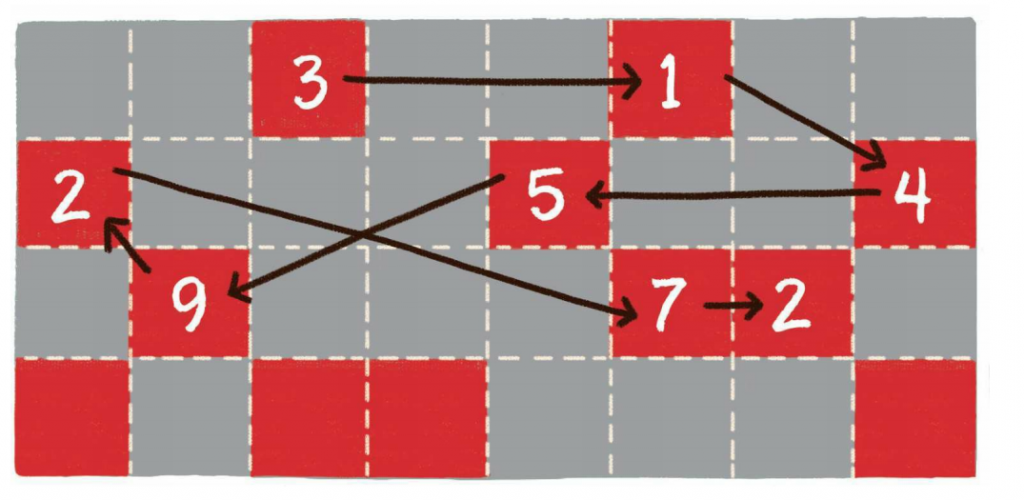
链表的第1个节点被称为头节点(3),没有任何节点的next指针指向它,或者说它的前置节点为空。头节点用来记录链表的基地址,有了它,我们就可以遍历得到整条链表。链表的最后1个节点被称为尾节点(2),它指向的next为空。
操作
- 查找节点
在查找元素时,链表只能从头节点开始向后一个一个节点逐一查找:

- 更新节点
找到要更新的节点,然后把旧数据替换成新数据:

- 插入节点
尾部插入
把最后一个节点的next指针指向新插入的节点即可:

头部插入
第1步,把新节点的next指针指向原先的头节点
第2步,把新节点变为链表的头节点
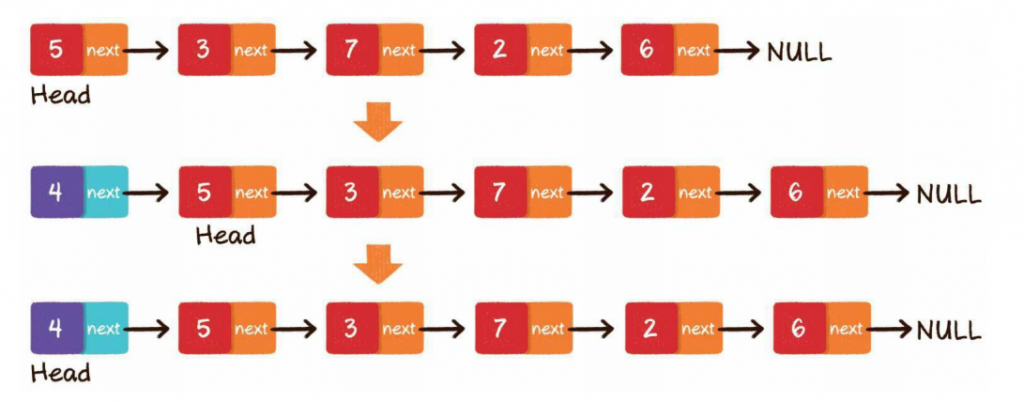
中间插入
第1步,新节点的next指针,指向插入位置的节点
第2步,插入位置前置节点的next指针,指向新节点
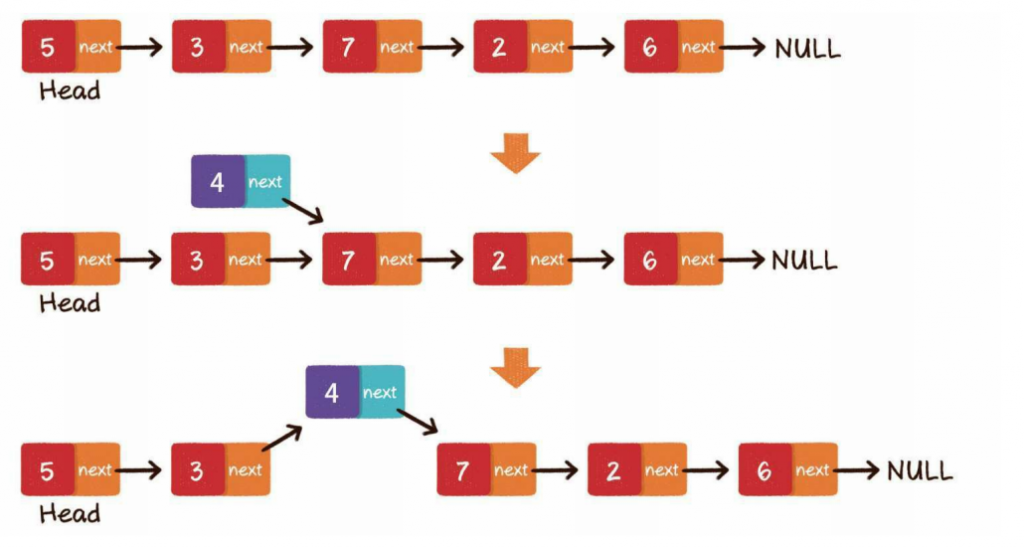
只要内存空间允许,能够插入链表的元素是无限的,不需要像数组那样考虑扩容的问题。
- 删除节点
尾部删除
把倒数第2个节点的next指针指向空即可:

头部删除
把链表的头节点设为原先头节点的next指针即可:
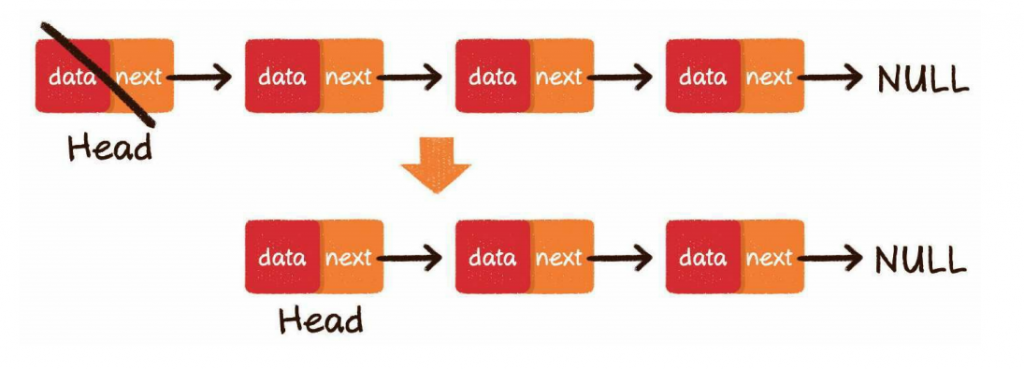
中间删除
把要删除节点的前置节点的next指针,指向要删除元素的下一个节点即可:

完整代码:
package com.rubin.datastructure.linkedlist;
import lombok.Data;
@Data
public class RubinNode {
private int id;
private String name;
private RubinNode next;
public RubinNode() {
}
public RubinNode(int id, String name) {
this.id = id;
this.name = name;
}
@Override
public String toString() {
return "RubinNode{" +
"id=" + id +
", name='" + name + '\'' +
'}';
}
}
package com.rubin.datastructure.linkedlist;
public class RubinLinkedList {
private RubinNode head;
public RubinLinkedList() {
this.head = new RubinNode(0, "");
}
/**
* 添加节点:从头插入
*
* @param node
*/
public void addNode(RubinNode node) {
//从头插入
RubinNode tmp = head;
while (true) {
//到尾节点
if (tmp.getNext() == null) {
break;
}
//后移一个节点
tmp = tmp.getNext();
}
tmp.setNext(node);
}
public void addByIdOrder(RubinNode node) {
//从头插入
RubinNode tmp = head;
while (true) {
//到尾节点
if (tmp.getNext() == null) {
break;
}
//节点存在
if (tmp.getNext().getId() == node.getId()) {
break;
}
if (tmp.getNext().getId() > node.getId()) {
break;
}
tmp = tmp.getNext();
}
//交换位置
node.setNext(tmp.getNext());
tmp.setNext(node);
}
public void showList() {
if (head.getNext() == null) {
System.out.println("the list is empty");
return;
}
RubinNode tmp = head.getNext();
while (tmp != null) {
System.out.println(tmp);
tmp = tmp.getNext();
}
}
}
package com.rubin.datastructure.linkedlist;
public class Main {
public static void main(String[] args) {
RubinNode n1 = new RubinNode(1, "张飞");
RubinNode n2 = new RubinNode(2, "关羽");
RubinNode n3 = new RubinNode(3, "赵云");
RubinNode n4 = new RubinNode(4, "黄忠");
RubinNode n5 = new RubinNode(5, "马超");
RubinLinkedList rubinLinkedList = new RubinLinkedList();
rubinLinkedList.addByIdOrder(n4);
rubinLinkedList.addByIdOrder(n5);
rubinLinkedList.addByIdOrder(n1);
rubinLinkedList.addByIdOrder(n2);
rubinLinkedList.addByIdOrder(n3);
rubinLinkedList.showList();
}
}
时间复杂度
查找节点 : O(n)
插入节点:O(1)
更新节点:O(1)
删除节点:O(1)
优缺点
- 优势
插入、删除、更新效率高
省空间
- 劣势
查询效率较低,不能随机访问
应用
链表的应用也非常广泛,比如树、图、Redis的列表、LRU算法实现、消息队列等。
数组与链表的对比
数据结构没有绝对的好与坏,数组和链表各有千秋。
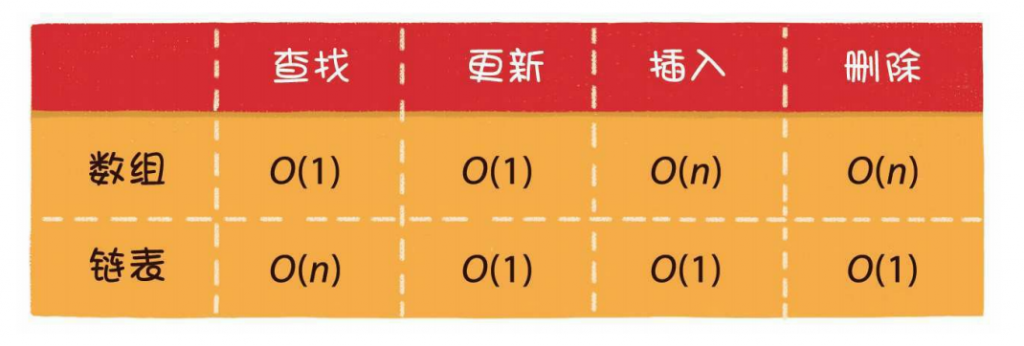
数组的优势在于能够快速定位元素,对于读操作多、写操作少的场景来说,用数组更合适一些。
链表的优势在于能够灵活地进行插入和删除操作,如果需要在尾部频繁插入、删除元素,用链表更合适一些。
数组和链表是线性数据存储的物理存储结构:即顺序存储和链式存储。
栈
栈和队列都属于线性数据的逻辑存储结构。
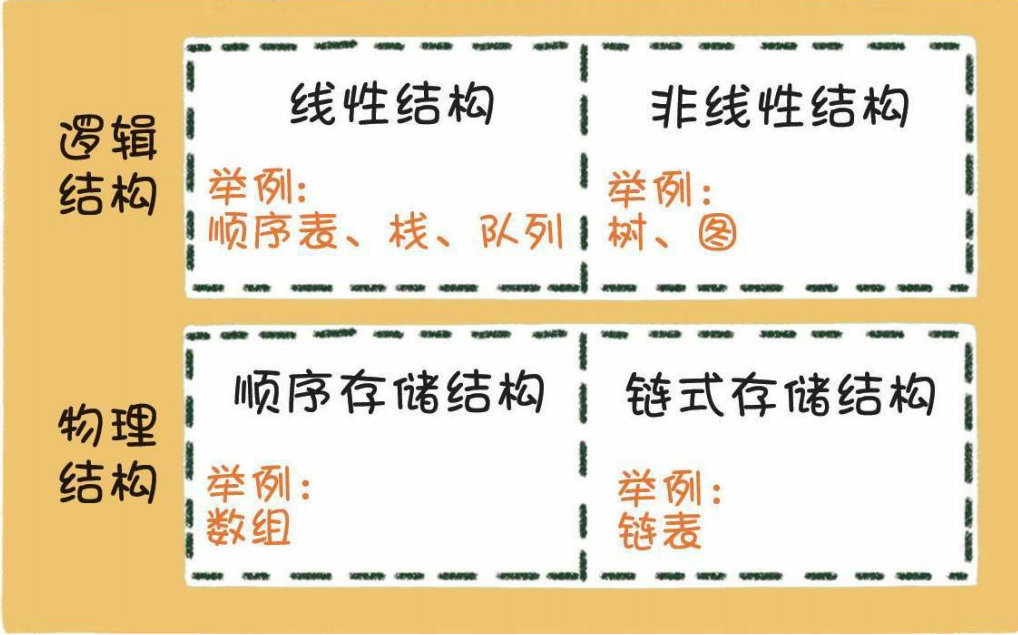
概念
栈(stack)是一种线性数据结构,栈中的元素只能先入后出(First In Last Out,简称FILO)。
最早进入的元素存放的位置叫作栈底(bottom),最后进入的元素存放的位置叫作栈顶 (top)。
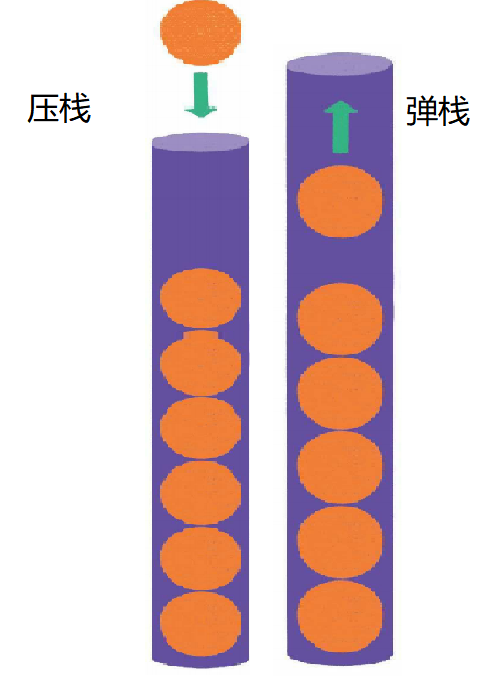
存储原理
栈既可以用数组来实现,也可以用链表来实现。
栈的数组实现如下:

数组实现的栈也叫顺序栈或静态栈。
栈的链表实现如下:

链表实现的栈也叫做链式栈或动态栈。
操作
- 入栈(压栈)
入栈操作(push)就是把新元素放入栈中,只允许从栈顶一侧放入元素,新元素的位置将会成为新的栈顶:


- 出栈(弹栈)
出栈操作(pop)就是把元素从栈中弹出,只有栈顶元素才允许出栈,出栈元素的前一个元素将会成为新的栈顶:

完整代码:
数组实现:
package com.rubin.datastructure.stack;
public class RubinArrayStack {
private int[] items;
private int size;
public RubinArrayStack(int cap) {
items = new int[cap];
size = 0;
}
public boolean push(int item) {
if (size == items.length) {
return false;
}
items[size] = item;
++size;
return true;
}
public int pop() {
if (size == 0) {
return 0;
}
--size;
return items[size];
}
public static void main(String[] args) {
RubinArrayStack rubinArrayStack = new RubinArrayStack(10);
rubinArrayStack.push(3);
rubinArrayStack.push(1);
rubinArrayStack.push(5);
rubinArrayStack.push(2);
rubinArrayStack.push(7);
System.out.println(rubinArrayStack.pop());
System.out.println(rubinArrayStack.pop());
System.out.println(rubinArrayStack.pop());
System.out.println(rubinArrayStack.pop());
System.out.println(rubinArrayStack.pop());
}
}
链表实现:
package com.rubin.datastructure.stack;
public class RubinLinkedStack {
private RubinStackNode head;
private int size;
public RubinLinkedStack() {
size = 0;
}
public void push(int item) {
if (size == 0) {
head = new RubinStackNode(item);
} else {
RubinStackNode newHead = new RubinStackNode(item);
newHead.next = head;
head = newHead;
}
++size;
}
public int pop() {
if (size == 0) {
return 0;
}
RubinStackNode oldHead = head;
head = head.next;
--size;
return oldHead.value;
}
static class RubinStackNode {
int value;
RubinStackNode next;
public RubinStackNode(int value) {
this.value = value;
}
}
public static void main(String[] args) {
RubinLinkedStack rubinLinkedStack = new RubinLinkedStack();
rubinLinkedStack.push(1);
rubinLinkedStack.push(2);
rubinLinkedStack.push(3);
rubinLinkedStack.push(4);
rubinLinkedStack.push(5);
System.out.println(rubinLinkedStack.pop());
System.out.println(rubinLinkedStack.pop());
System.out.println(rubinLinkedStack.pop());
System.out.println(rubinLinkedStack.pop());
System.out.println(rubinLinkedStack.pop());
}
}
时间复杂度
入栈和出栈的时间复杂度都是O(1)
支持动态扩容的顺序栈
当数组空间不够时,我们就重新申请一块更大的内存,将原来数组中数据统统拷贝过去。这样就实现了一个支持动态扩容的数组,入栈的时间复杂度是O(n)。
应用
- 函数调用
每进入一个函数,就会将临时变量作为一个栈入栈,当被调用函数执行完成,返回之后,将这个函数对应的栈帧出栈。
- 浏览器的后退功能
我们使用两个栈,X 和 Y,我们把首次浏览的页面依次压入栈 X,当点击后退按钮时,再依次从栈X 中出栈,并将出栈的数据依次放入栈 Y。当我们点击前进按钮时,我们依次从栈 Y 中取出数据,放入栈 X 中。当栈 X 中没有数据时,那就说明没有页面可以继续后退浏览了。当栈 Y 中没有数据,那就说明没有页面可以点击前进按钮浏览了。
队列
概念
队列(queue)是一种线性数据结构,队列中的元素只能先入先出(First In First Out,简称 FIFO)。队列的出口端叫作队头(front),队列的入口端叫作队尾(rear)。


存储原理
队列这种数据结构既可以用数组来实现,也可以用链表来实现。
- 数组实现

用数组实现时,为了入队操作的方便,把队尾位置规定为最后入队元素的下一个位置。
用数组实现的队列叫作顺序队列。
- 链表实现

用链表实现的队列叫作链式队列。
操作
- 入队
入队(enqueue)就是把新元素放入队列中,只允许在队尾的位置放入元素,新元素的下一个位置将会成为新的队尾:
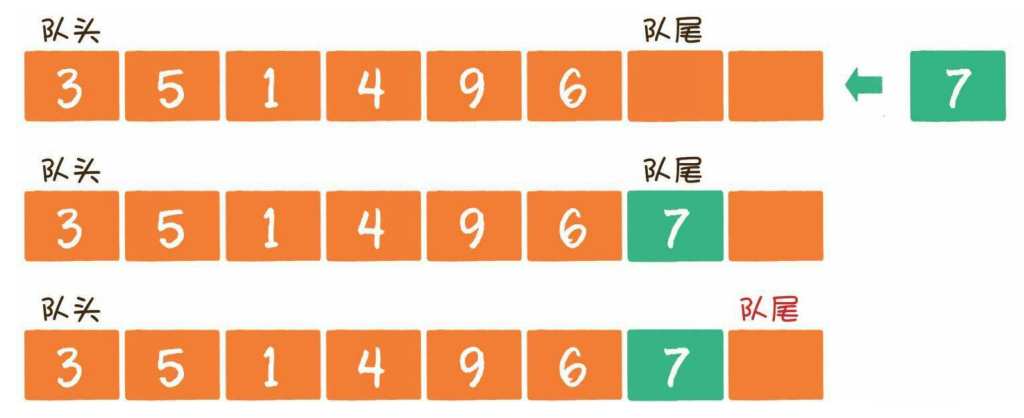
- 出队
出队操作(dequeue)就是把元素移出队列,只允许在队头一侧移出元素,出队元素的后一个元素将会成为新的队头:

完整代码:
数组实现:
package com.rubin.datastructure.queue;
public class RubinArrayQueue {
private int[] items;
private int head, tail;
private int size;
public RubinArrayQueue(int cap) {
items = new int[cap];
head = tail = size = 0;
}
public boolean enqueue(int item) {
if (size == items.length) {
return false;
}
items[tail] = item;
++size;
++tail;
if (tail == items.length) {
tail = 0;
}
return true;
}
public int dequeue() {
if (size == 0) {
return 0;
}
int result = items[head];
--size;
++head;
if (head == items.length) {
head = 0;
}
return result;
}
public static void main(String[] args) {
RubinArrayQueue rubinArrayQueue = new RubinArrayQueue(10);
for (int i = 0; i < 10; i++) {
rubinArrayQueue.enqueue(i);
}
for (int j = 0; j < 10; j++) {
System.out.println(rubinArrayQueue.dequeue());
}
}
}
链表实现:
package com.rubin.datastructure.queue;
public class RubinLinkedQueue {
private RubinQueueNode head;
private RubinQueueNode tail;
private int size;
public RubinLinkedQueue() {
head = tail = null;
size = 0;
}
static class RubinQueueNode {
int value;
RubinQueueNode next;
public RubinQueueNode(int value) {
this.value = value;
}
}
public void enqueue(int item) {
if (size == 0) {
head = tail = new RubinQueueNode(item);
} else {
RubinQueueNode newTail = new RubinQueueNode(item);
tail.next = newTail;
tail = newTail;
}
++size;
}
public int dequeue() {
if (size == 0) {
return 0;
}
RubinQueueNode h = head;
int result = h.value;
head = head.next;
--size;
h.next = null;
return result;
}
public static void main(String[] args) {
RubinLinkedQueue rubinLinkedQueue = new RubinLinkedQueue();
for (int i = 0; i < 10; i++) {
rubinLinkedQueue.enqueue(i);
}
for (int j = 0; j < 10; j++) {
System.out.println(rubinLinkedQueue.dequeue());
}
}
}
时间复杂度
入队和出队都是O(1)。
应用
资源池、消息队列、命令队列等等。
以上就是本文的全部内容。欢迎各位小伙伴积极留言交流~~~


文章评论